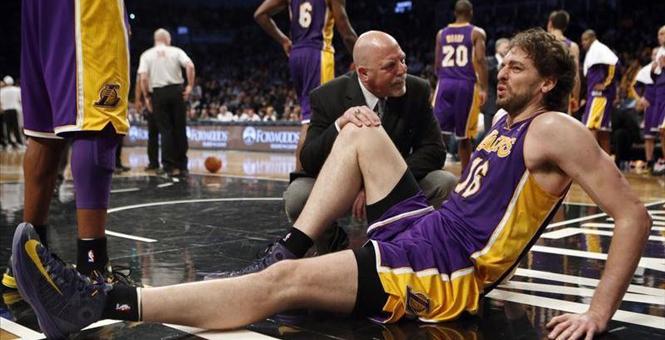by Bruce Williams, D.P.M
Breakthrough Podiatry, Merrillville, Indiana
219.769.0977

What do Paul Gasol, Ty Lawson, and Rip Hamilton (aptly named) have in common? They both suffered from acute plantar fascia ruptures during the 2012-2013 NBA season.
Most sports medical professionals are familiar with plantar fasciitis, the acute presentation of plantar heel pain. Plantar fasciosis, as the chronic condition is now referred, is the continuation of heel pain for 6-8 weeks or more. It has been suggested that there are approximately 2 million cases of plantar fasciitis /osis per year,(1,2). A study on injuries in the NBA found that foot inflammation was responsible for approximately 3.5% of all games missed, an estimated 90 games a year, and was 2.9% of all injuries tracked, (3).
Plantar fascia rupture is not uncommon in patients with chronic plantar fasciosis as is often the case with ruptures of tendons suffering from chronic tendinosis, think Chauncy Billups and Kobe Bryant. Non-inflammatory tissue changes with thickening of the fascial and muscular fibers and in-growth of vasculature at the level of spur insertion are commonly found histologically and through ultrasonography, (4,5) in both conditions.
Plantar fascia ruptures more often occur in athletes who run, jump and cut as part of the activity in their sport. Most ruptures, partial or complete, occur with forced plantar flexion of the foot. Repeated stress, and / or minor trauma to the fascia can cause a rupture as well, and spontaneous ruptures that happen are often associated with recent local steroid injections, (6,7,8). Plantar fascia rupture does not seem to be tracked regularly, but during this NBA season it would seem to be numerically on track with ACL injuries of the knee.
Plantar fascia ruptures usually present with the sound of a “pop”, acute pain, bruising and swelling, and inability to push-off of the foot or to fully weight-bear without significant pain. Once the fascia is ruptured, little can be done to repair it and it usually is left to form scar tissue to bridge the gap created.
Usual treatment after rupture consists of the use of a removable walking boot and crutches for the athlete to remain non-weight bearing for 1-2 weeks. Once the athlete can bear weight pain free in the walking boot, they may dispense with the use of the crutches and continue with the boot, finally transitioning to shoes when able. Daily therapy treatments, stretching exercises and OTC or custom foot orthoses are usually instituted immediately as tolerated. Platelet Rich Plasma or PRP injections are being used often now during treatment, but no long term studies have been done specifically regarding plantar fascia rupture. One study presented at the AAOS meeting in 2012 showed earlier improvement and longer lasting improvement in comparing a single injection of steroid in a group of patient’s vs a single PRP injection in a group of patients, (8). A study by Saxena and Fullem 2004 (9), looked specifically at plantar fascia rupture in athletes. They estimated a total recovery time of 9.1 weeks +/- 6 weeks. In the NBA this could translate into a loss of 10-30 games or more.
The implications of plantar fascia rupture can be significant in the foot and lower extremity. Once the fascia is healed it is almost always longer, at the medial or central band, than it was prior to rupture. While this may decrease local medial and plantar heel pain, the decrease in tension of the fascia in stance and propulsion phases of gait can prolong pronation forces in the foot, flatten the longitudinal arch and increase pressures in the forefoot, (10). Lateral column pain is not uncommon after surgical plantar fascia release, and can occur in traumatic release as well. This occurs because the medial column will now be less stable and the neuromuscular feedback will seek stability, by shifting the center of force in the foot to either the stable lateral or central metatarsals. This can lead to a higher risk of metatarsal stress fracture and potential worsening of hammer toe deformities as the toes seek to grip the ground to stabilize a hypermobile first ray, (11). To properly analyze the problem, a functional and structural scoring system must evaluate the foot to see root problems. Treating only the symptoms can manage the pain, but compensations will occur if there is not a thorough assessment of the mechanics of the foot.
Custom foot orthoses, if prescribed correctly, can combat most of the forces that will lead to chronic plantar fasciosis as well as plantar fascia rupture before and after occurrence. In the study by Saxena and Fullem (9) they found that about 25% of the athletes prior to plantar fascia rupture used foot orthoses. More interesting to note was that post-rupture 75% of the athletes were prescribed and wore foot orthoses. Most professional athletes have and often will wear their custom foot orthoses. If these same athletes continue to suffer from plantar fasciosis symptoms then it would seem in most instances that the devices are either not being regularly worn or do not have the appropriate prescription. The use of in-shoe pressure analysis, alone or in conjunction with video analysis, can quantitate bilateral foot function. Asymmetries in function such as acceleration differences right to left, early loss of heel contact and shifting of the center of force more lateral than medial can all be recorded and documented for further review at any time. Eliminating these asymmetries via specific segmental orthosis prescription elements will, in most cases, dramatically decrease the pain and improper forces acting on the foot and lower extremity, (12). Small razor thin othoses can create subtle yet measurable improvements in foot mechanics and function from the foot and up the kinetic chain.
When dealing with a highly paid professional athletic population it does not make sense to just treat the symptoms of chronic plantar fasciosis. Overuse during a season is a given in professional sports. Interventions, regardless of which ones, should show significant improvement or should be investigated further and quantified if possible to achieve the best possible outcome for the athlete and the team. Team medical and performance staff are under a lot of pressure to keep athletes healthy, so documentation with objective data sets such as biomechanical and medical imaging is imperative.
Special Thanks To:
References
- Pribut S. Current Approaches to the Management of Plantar Heel Pain Syndrome, Including the Role of Injectable Corticosteroids J Am Podiatr Med Assoc 97(1): 68-74, 2007
- Martin J, Hosch J, et al. Mechanical Treatment of Plantar Fasciitis A Prospective Study J Am Podiatr Med Assoc 91(2): 55-62, 2001
- Drakos M, Domb B, et al. Injury in the National Basketball Association: A 17-Year Overview. Sports Health: A Multidisciplinary Approach March 10, 2010.
- Sarah Mahowald S, Legge B. The Correlation Between Plantar Fascia Thickness and Symptoms of Plantar Fasciitis. J Am Podiatr Med Assoc 101(5): 385-389, 2011
- Lemont H, Ammirati K. Plantar Fasciitis A Degenerative Process (Fasciosis) Without Inflammation. J Am Podiatr Med Assoc 93(3): 234-237, 2003
- Theodorou D, Theodorou S, et al. Plantar Fasciitis and Fascial Rupture: MR Imaging Findings in 26 Patients Supplemented with Anatomic Data in Cadavers. RadioGraphics 2000; 20:S181–S197
- Kim C, Cashdollar M, et al. Incidence of Plantar Fascia Ruptures Following Corticosteroid Injection. Foot Ankle Spec 2010 3: 335
- Monto R. Platelet-Rich Plasma is More Effective than Cortisone for Chronic Severe Plantar Fasciitis Paper presented at AAOS 2012 Tuesday, Feb 07, 2012, 11:06 AM -11:12 AM.
- Saxena A, Fullem B. Plantar fascia ruptures in athletes. Am J Sports Med. 2004 Apr-May;32(3):662-5.
- Tatli Y, Kapasi S. The real risks of steroid injection for plantar fasciitis, with a review of conservative therapies. Curr Rev Musculoskelet Med (2009) 2:3–9
- Kim C, Cashdollar M, et al. Incidence of Plantar Fascia Ruptures Following Corticosteroid Injection. Foot Ankle Spec 2010 3: 335
- Williams B, Yakel J. Clinical Uses of In-Shoe Pressure Analysis in Podiatric Sports Medicine. J Am Podiatr Med Assoc 97(1): 49-58, 2007




